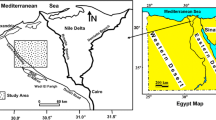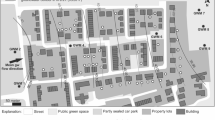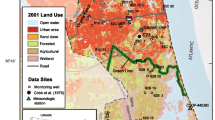Abstract
This study investigated the thermal regime of shallow groundwater in the Turin area (NW Italy), where the large energy demand has motivated a new interest for renewable sources, such as the use of ground-source heat pumps for domestic heating and cooling. The vertical variability of the groundwater temperature between the ground surface and 10–20 m was detected: deeper temperatures were higher than shallow temperatures in spring, while a decrease with depth occurred in autumn. These variations are connected with the heating and cooling cycles of the ground surface due to the seasonal temperature oscillation. Variations below the seasonal oscillation are likely to be connected with the presence of advective heat transport due to the groundwater flow, according to the hydraulic features of a shallow aquifer. Temperature values mostly ranged between 12 and 14 °C in rural areas, while the values were between 14 and 16 °C below the Turin city. This groundwater warming is attributed to a widespread urban heat island phenomenon linked to warmer land surface temperatures in Turin city. Sparse warm outliers are connected with point heat sources and site-specific conditions of land and subsurface use, which may cause the aquifer temperature to rise. A relatively stable temperature below the seasonal fluctuation zone combined with high productivity and legislated limits for deeper groundwater use represent favourable conditions for a large-scale diffusion of groundwater heat pumps within the shallow aquifer. Moreover, this heat surplus should be regarded as a resource for future geothermal installations.








Similar content being viewed by others
References
Agenzia Regionale per la Protezione Ambientale (2007) Il Piemonte nel cambiamento climatico. Osservazioni passate, impatti presenti e strategie future. ARPA Piemonte, Torino
Allen A, Milenic D, Sikora P (2003) Shallow gravel aquifers and the urban heat island effect: a source of low enthalpy geothermal energy. Geothermics 32:569–578. doi:10.1016/S0375-6505(03)00063-4
Anderson MP (2005) Heat as a ground water tracer. Ground Water 43(6):951–968. doi:10.1111/j.1745-6584.2005.00052.x
Arola T, Korkka-Niemi K (2014) The effect of urban heat islands on geothermal potential: examples from Quaternary aquifers in Finland. Hydrogeol J 22:1953–1967. doi:10.1007/s10040-014-1174-5
Baccino G, Lo Russo S, Taddia G, Verda V (2010) Energy and environmental analysis of an open-loop ground-water heat pump system in an Urban area. Thermal Sci 14(3):693–706
Baietto A, Cadoppi P, Martinotti G, Perello P, Perrochet P, Vuataza F-D (2008) Assessment of thermal circulations in strike-slip fault systems: the Terme di Valdieri case (Italian western Alps). Geol Soc Lond Spec Publ 299:317–339. doi:10.1144/SP299.19
Banks D (2008) An introduction to thermogeology: ground source heating and cooling. Blackwell, Oxford
Barbero D, De Luca DA, Forno MG, Lasagna M, Magnea L (2014) A statistical approach to the study of thermal data of shallow aquifer in Piedmont region (NW ITALY). Abstracts book of DAMES 2014: 4th international conference on data analysis and modeling in earth sciences, Milano 6–8th October 2014
Barbero D, De Luca DA, Forno MG, Lasagna M (2016) Preliminary results on temperature distribution in the Quaternary fluvial and outwash deposits of the Piedmont Po Plain (NW Italy): a statistical approach. Rend Online Soc Geol It 41:272–275
Bayer P, Rivera JA, Schweizer D, Schärli U, Blum P (2016) Extracting past atmospheric warming and urban heating effects from borehole temperature profiles. Geothermics 64:289–299. doi:10.1016/j.geothermics.2016.06.011
Benz SA, Bayer P, Menberg K, Jung S, Blum P (2015) Spatial resolution of anthropogenic heat fluxes into urban aquifers. Sci Total Environ 524:427–439
Beretta GP, Coppola G, Della Pona L (2014) Solute and heat transport in groundwater similarity: model application of a high capacity open-loop heat pump. Geothermics 51:63–70. doi:10.1016/j.geothermics.2013.10.009
Bortolami G, De Luca DA, Filippini G (1988) Caratteristiche geolitologiche e geoidrologiche della pianura torinese. In: Le acque sotterranee della pianura di Torino. Aspetti e problemi. Provincia di. Torino, M/SLit, Torino
Bortolami G, De Luca DA, Masciocco L, Morelli di Popolo e Ticineto A (2002) Le acque sotterranee della Pianura di Torino: carta della base dell’acquifero superficiale. Note illustrative. Provincia di Torino, Torino
Bove A, Casaccio D, Destefanis E, De Luca DA, Lasagna M, Masciocco L, Ossella L, Tonussi M (2005) Idrogeologia della pianura piemontese. Regione Piemonte, Torino
Burns ER, Ingebritsen SE, Manga M, Williams CF (2016) Evaluating geothermal and hydrogeologic controls on regional groundwater temperature distribution. Water Resour Res 52:1328–1344
Cortemiglia GC (1999) Serie climatiche ultracentenarie. Regione Piemonte–Università degli Studi di Torino 3:1–91
De Luca DA, Destefanis E, Forno MG, Lasagna M, Masciocco L (2014) The genesis and the hydrogeological features of the Turin Po Plain fontanili, typical lowland springs in Northern Italy. Bull Eng Geol Environ 73:409–427. doi:10.1007/s10064-013-0527-y
Debernardi L, De Luca DA, Lasagna M (2008) Correlation between nitrate concentration in groundwater and parameter affecting aquifer intrinsic vulnerability. Environ Geol 55:539–558. doi:10.1007/s00254-007-1006-1
European Commission (2007) Italy renewable energy fact sheet. https://www.energy.eu/renewables/factsheets/2008_res_sheet_italy_en.pdf. Accessed 20 Sept 2016
European Commission (2015) Italy’s third progress report under directive 2009/28/EC. http://ec.europa.eu/energy/node/70. Accessed 13 April 2016
Ferguson G, Woodbury AD (2004) Subsurface heat flow in an urban environment. J Geophys Res 109:B02402. doi:10.1029/2003JB002715
Festa A, Boano P, Irace A, Lucchesi S, Forno MG, Dela Pierre F, Fioraso G, Piana F (2009) Foglio 156 “Torino Est” della Carta Geologica d’Italia alla scala 1:50.000. APAT, Agenzia per la Protezione dell’Ambiente e per i Servizi Tecnici—Dipartimento Difesa del Suolo, Roma
Forno MG, Gregorio L, Vatteroni R (2009) La successione stratigrafica del settore destro del Conoide di Lanzo e il suo significato per l’utilizzo del territorio. Mem Soc Geogr It 87(I–II):237–247
Garzena D, Fratianni S, Acquaotta F (2014) Considerazioni sull’isola di calore urbana di Torino attraverso l’analisi dei dati climatici. Geol Amb 1(suppl):90–97
Irace A, Clemente P, Natalicchio M, Ossella L, Trenkwalder S, De Luca DA, Mosca P, Piana F, Polino R, Violanti D (2009) Geologia e idrostratigrafia profonda della Pianura Padana occidentale. La Nuova Lito, Firenze
Lasagna M, De Luca DA, Franchino E (2016a) Nitrate contamination of groundwater in the western Po Plain (Italy): the effects of groundwater and surface water interactions. Environ Earth Sci 75:240. doi:10.1007/s12665-015-5039-6
Lasagna M, De Luca DA, Franchino E (2016b) The role of physical and biological processes in aquifers and their importance on groundwater vulnerability to nitrate pollution. Environ Earth Sci 75:961. doi:10.1007/s12665-016-5768-1
Lo Russo S, Taddia G, Cerino Abdin E (2015) Potential of shallow aquifers in the plain sector of Piemonte region (NW Italy) for groundwater heat pumps diffusion. Rend Online Soc Geol It 35:180–183
Menberg K, Bayer P, Zosseder K, Rumohr S, Blum P (2013) Subsurface urban heat islands in German cities. Sci Total Environ 442:123–133. doi:10.1016/j.scitotenv.2012.10.0437
Oke TR (1995) The heat island characteristics of urban boundary layer: characteristics, causes and effects. Wind climate in cities. Springer, Netherlands, pp 81–107
Pasquale V, Verdoya M, Chiozzi P (2011) Groundwater flow analysis using different geothermal constraints: the case study of Acqui Terme area, northwestern Italy. J Volc Geotherm Res 199:38–46. doi:10.1016/j.jvolgeores.2010.10.003
Perello P, Marini L, Martinotti G, Hunziker JC (2001) The thermal circuits of the Argentera Massif (western Alps, Italy). An example of low-enthalpy geothermal resources controlled by Neogene alpine tectonics. Eclogae Geol Helv 94:75–94
Rybach L, Eugster WJ (2010) Sustainability aspects of geothermal heat pump operation, with experience from Switzerland. Geothermics 39:365–369. doi:10.1016/j.geothermics.2010.08.002
Sparacino M, Camussi M, Colombo M, Carella R, Sommaruga C (2007) The world’s largest geothermal district heating using ground water under construction in Milan (Italy)-AEM unified heat pump project. In: Proceeding of European geothermal congress, Unterhaching, Germany, vol 30
Silliman SE, Booth DF (1993) Analysis of time-series measurements of sediment temperature for identification of gaining vs. losing portions of Juday Creek, Indiana. J Hydrol 146:131–148
Stauffer F, Bayer P, Blum P, Molina-Giraldo N, Kilzenbach W (2013) Thermal use of shallow subsurface. CRC Press, Boca Raton
Stringari M, Balsotti R, De Luca DA (2010) Le caratteristiche termiche dell’acquifero superficiale della Regione Piemonte. Acque Sotter 121:29–42
Taniguchi M (1993) Evaluation of vertical groundwater fluxes and thermal properties of aquifers based on transient temperature-depth profiles. Water Resour Res 29(7):2021–2026
Taniguchi MJ, Shimada T, Tanaka I, Kayane Y, Sakura Y, Shimano S, Dapaah-Siakwan S, Kawashima S (1999) Disturbances of temperature-depth profiles due to surface climate change and subsurface water flow: 1. An effect of linear increase in surface temperature caused by global warming and urbanization in the Tokyo metropolitan area, Japan. Water Resour Res 35(5):1507–1517
Taniguchi M, Uemura T, Jago-on K (2007) Combined effects of urbanization and global warming on subsurface temperature in four Asian cities. Vadose Zone J 6:591–596. doi:10.2136/vzj2006.0094
Taylor CA, Stefan HG (2009) Shallow groundwater temperature response to climate change and urbanization. J Hydrol 375:601–612. doi:10.1016/j.jhydrol.2009.07.009
Voogt J (2004) Urban heat islands: hotter cities. http://www.actionbioscience.org/environment/voogt.html. Last accessed 19 Jan 2017
Zhu K, Blum P, Ferguson G, Balke KD, Bayer P (2010) The geothermal potential of urban heat islands. Environ Res Lett 5:044002. doi:10.1088/1748-9326/5/4/044002
Acknowledgements
Most of the groundwater monitoring points were accessed thanks to the kind support of Arpa Piemonte and Provincia di Torino. The authors are grateful to all collaborators as well as to all the private institutions and individuals who permitted access to other monitoring wells. The authors deeply thank the reviewer for useful comments and suggestions that helped to improve the paper.
Author information
Authors and Affiliations
Corresponding author
Rights and permissions
About this article
Cite this article
Bucci, A., Barbero, D., Lasagna, M. et al. Shallow groundwater temperature in the Turin area (NW Italy): vertical distribution and anthropogenic effects. Environ Earth Sci 76, 221 (2017). https://doi.org/10.1007/s12665-017-6546-4
Received:
Accepted:
Published:
DOI: https://doi.org/10.1007/s12665-017-6546-4




